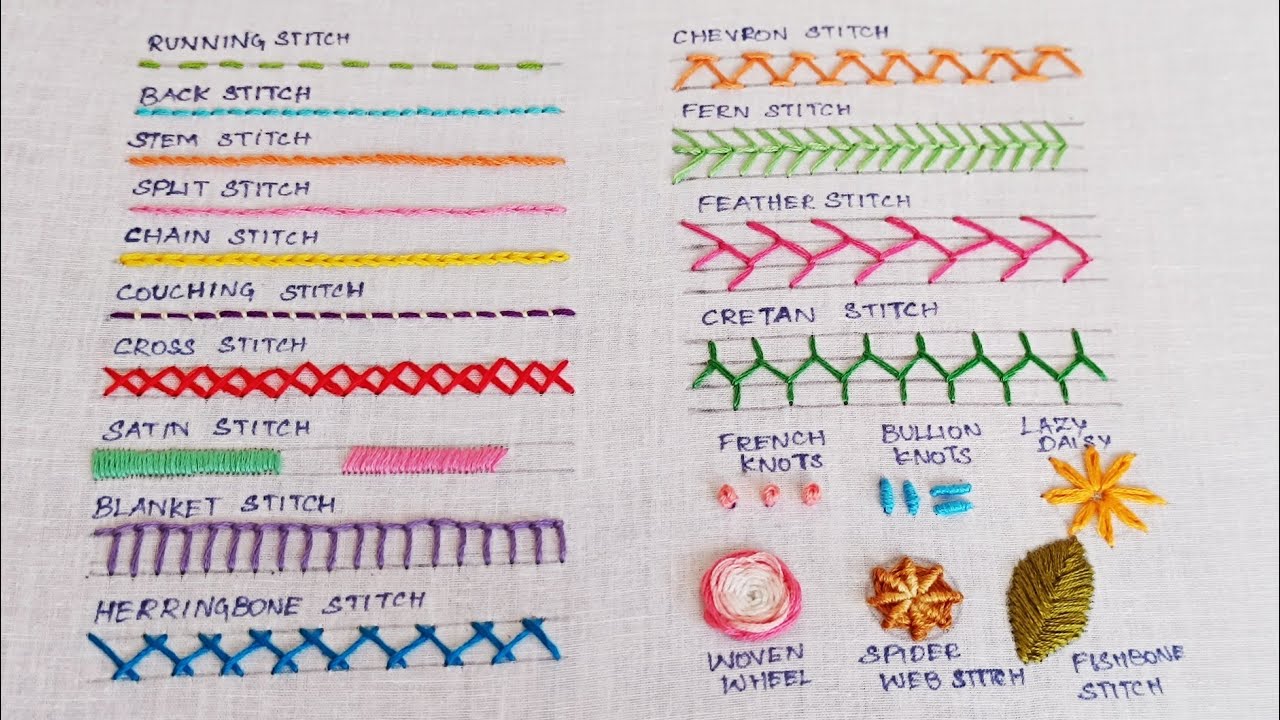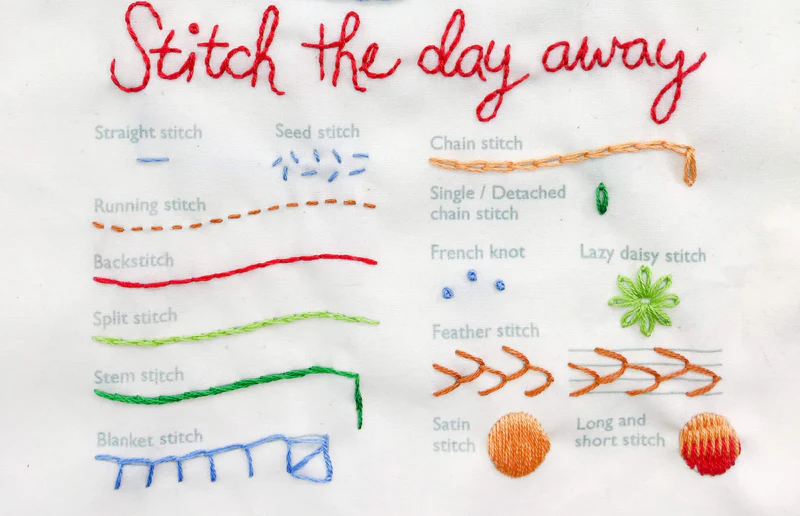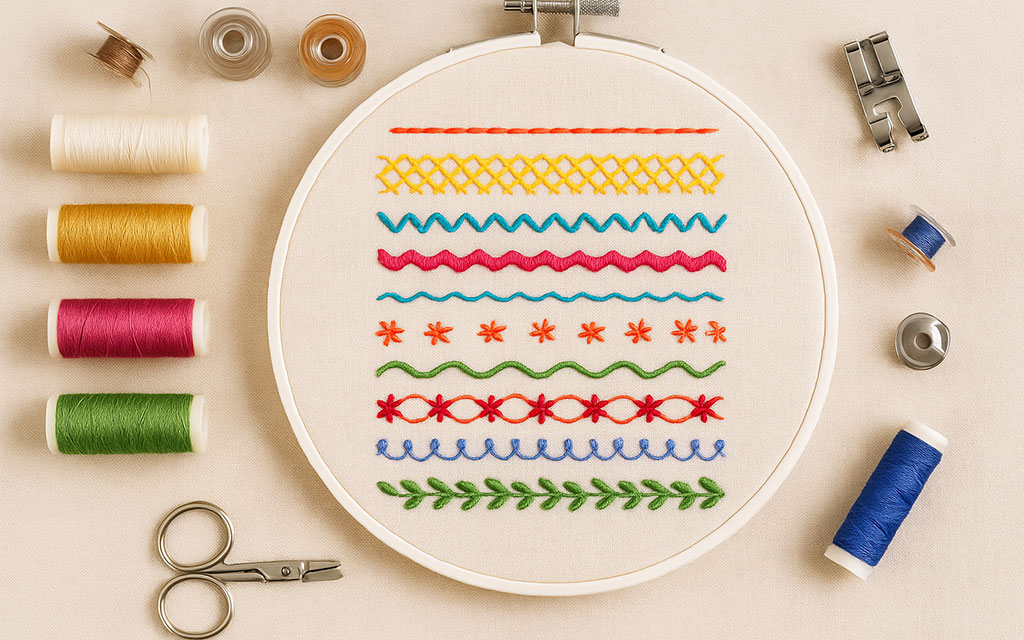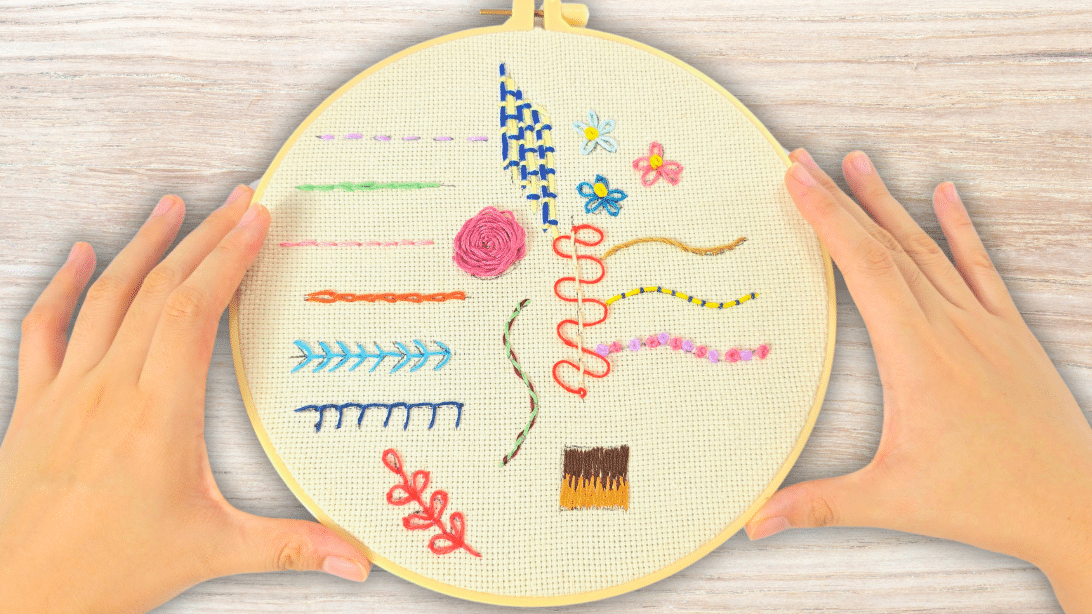Embroidery is one of the oldest and most creative forms of needlework, connecting generations through the art of thread and fabric. Whether you’re stitching for relaxation, decorating your home, or creating handmade gifts, understanding embroidery stitches is essential to crafting beautiful and durable designs.
In this complete guide, you’ll learn about basic embroidery stitches, explore the variety of hand embroidery stitches, and discover how to use them effectively in your projects. By the end, you’ll have the knowledge and confidence to turn simple threads into stunning works of art.
What Are Embroidery Stitches?

Embroidery stitches are the techniques used to sew thread onto fabric to create decorative designs, text, or patterns. Each stitch type serves a purpose – some are perfect for outlines, others for filling shapes, and some add texture or intricate detail.
From simple beginner stitches like the running stitch to more artistic stitches like the French knot, mastering the basics gives you the flexibility to experiment with any embroidery pattern or kit.
Why Learning Embroidery Stitches Matters
Many beginners underestimate the importance of learning stitch structure. Understanding the correct technique ensures:
- Clean, even results that look professional
- Faster progress with fewer mistakes
- Longer-lasting embroidery that doesn’t unravel
- Confidence to take on more complex designs
Even when using pre-designed embroidery kits, having a grasp of basic embroidery stitches helps you personalize each piece with precision and creativity.
Essential Tools for Practicing Embroidery Stitches
Before you begin, make sure you have the right materials. Quality tools make a significant difference in the final outcome.
You’ll need:
Embroidery hoop – keeps your fabric tight for cleaner stitches
Embroidery needle – choose sizes based on thread and fabric thickness
Embroidery floss – colorful threads, typically 6-stranded cotton
Aida or linen fabric – ideal for beginners
Small scissors – for precise thread trimming
Embroidery kit – a great option for guided projects and ready-to-use materials
At the embroidery kits, we provide premium-quality embroidery kits for beginners and embroidery kits for adults, complete with instructions, pre-sorted threads, and beginner-friendly fabric.
Section 1: Basic Embroidery Stitches Every Beginner Should Know
If you’re new to embroidery, these basic embroidery stitches are the perfect place to start. They’re simple, versatile, and form the foundation of most designs.
1. Running Stitch
The running stitch is the simplest and most commonly used stitch. It’s perfect for outlining, creating borders, or adding simple texture.
How to do it: Pass the needle up and down through the fabric, keeping even spaces between stitches. Adjust the length depending on your design.
2. Backstitch
The backstitch is used for outlining shapes or adding text. It creates a solid line that’s smooth and continuous.
Pro tip: Keep your stitches short for curves and detailed outlines.
3. Split Stitch
The split stitch adds texture and strength to outlines. It’s similar to the backstitch but involves splitting the thread of the previous stitch.
Use it for: Lettering or outlining bold designs.
4. Stem Stitch
The stem stitch is often used for floral designs, vines, and curved lines. It creates a slightly twisted line that resembles a plant stem.
Best for: Natural and flowing outlines.
5. Satin Stitch
The satin stitch fills shapes with smooth, solid color.
Technique: Work closely packed stitches side by side until the area is completely covered.
Tip: Keep your stitches consistent in direction for a neat finish.
6. French Knot
A small, raised dot created by wrapping the thread around the needle before inserting it back into the fabric.
Use it for: Flower centers, eyes, or textured accents.
7. Chain Stitch
This stitch forms a linked chain pattern and is often used for outlines and decorative borders.
Variation: Try the detached chain (or lazy daisy stitch) for petal shapes.
8. Cross Stitch
A popular hand embroidery stitch, especially in counted cross stitch kits.
Each “X” is made by crossing two diagonal stitches on a gridded fabric.
Perfect for: Beginners and geometric designs.
9. Blanket Stitch
This decorative edge stitch is often used to finish fabric edges or appliqué work. It’s also known as the buttonhole stitch.
Best for: Edging napkins, blankets, or felt projects.
10. Seed Stitch
Tiny, random stitches scattered across an area to create texture.
Great for: Filling backgrounds or adding depth to embroidery patterns.
Section 2: Intermediate and Advanced Hand Embroidery Stitches
Once you’re comfortable with the basics, explore more advanced hand embroidery stitches to elevate your projects.
1. Long and Short Stitch
Used for shading and blending colors, this stitch creates a gradient-like effect.
Tip: Start with alternating long and short stitches, then layer with colors for a realistic finish.
2. Bullion Knot
This coiled stitch creates texture and volume, perfect for roses or intricate borders.
Practice note: It takes patience, but the results are stunning.
3. Feather Stitch
A flowing stitch that resembles feathers or vines, commonly used for decorative borders.
Ideal for: Floral and nature-inspired embroidery.
4. Herringbone Stitch
Creates a crisscross pattern, adding a beautiful woven effect.
Use for: Borders, seams, or filler backgrounds.
5. Couching Stitch
Involves laying a thread on the fabric and tacking it down with small stitches.
Excellent for: Using metallic or thicker threads that don’t easily pass through fabric.
Section 3: Common Mistakes Beginners Make (and How to Fix Them)
Uneven Tension: Avoid pulling the thread too tight; let it lie naturally on the fabric.
Skipping the Hoop: Always use a hoop to prevent puckering.
Ignoring Thread Direction: Keep stitches consistent for clean results.
Not Finishing Properly: Secure the back neatly to prevent unraveling.
Wrong Needle or Fabric: Match your needle and fabric count to thread thickness for balance.
Section 4: Practicing and Perfecting Your Stitches
Practice is key. Start by stitching on scrap fabric or using beginner embroidery kits that include guided patterns.
Tips for improvement:
- Try 15-20 minutes daily instead of long sessions.
- Focus on one stitch at a time until you can do it evenly.
- Combine stitches creatively – for example, backstitch for outlines and satin stitch for filling.
Keep your hands and workspace clean to avoid staining fabric.
Section 5: Using Embroidery Stitches in Real Projects
Now that you know the main hand embroidery stitches, put them to use:

Wall art: Frame your embroidery using a hoop or canvas.
Clothing: Personalize denim jackets, tote bags, or shirts.
Home decor: Embroidered pillows, napkins, and table runners.
Gifts: Handmade embroidery makes heartfelt, one-of-a-kind presents.
Section 6: Embroidery Kits – The Easiest Way to Learn Stitches
If you’re new to embroidery or want to practice specific stitches, The Embroidery Kits offers a variety of options:

Best Embroidery Kits: Premium designs with detailed instructions and top-quality materials.
Embroidery Kits for Adults: Relaxing, creative projects with advanced stitch patterns.
Embroidery Kits for Beginners: Simple, guided kits ideal for learning basic embroidery stitches.
Unique Embroidery Kits: One-of-a-kind themes and creative patterns to expand your skills.
Each kit includes everything you need – from pre-sorted threads and needles to step-by-step instructions. You can learn each embroidery stitch with confidence and produce something truly beautiful.
Section 7: Caring for Your Embroidery Work
To make your embroidery last:
- Gently hand wash finished pieces in cool water.
- Avoid wringing or twisting.
- Iron from the back on a low setting using a pressing cloth.
- Frame or store flat in a dry place to prevent damage.
Conclusion
Learning embroidery stitches is the foundation of mastering hand embroidery. Once you understand basic embroidery stitches, you can create endless designs, experiment with textures, and personalize your craft. Whether you stitch for fun, relaxation, or artistry, every stitch adds to your skill and creativity.
Start today with a beginner-friendly embroidery kit from The Embroidery Kits and watch your confidence-and your creations-grow one stitch at a time.

